Jambo is a game of trade, themed as an African Merchant game (the word ‘Jambo’ being a Swahili word meaning ‘hello’). All of the artwork is good; very bright and cheerful in tone. The game consists of a central deck (the card supply), a collection of wares (the supply), two large market stands (one for each player), tokens representing either one or five gold coins, and five action markers.
You start the game with 20 gold coins, a hand of five cards dealt from the card supply, and your large market stand. Randomly determine who will start the game and alternate turns from that point. If, at the end of any player’s turn, they have 60+ gold coins, the end of the game is triggered. This means their opponent gets one final turn. If that player can accumulate as much or more gold at the end of their final turn, they will win the game; else they will lose.
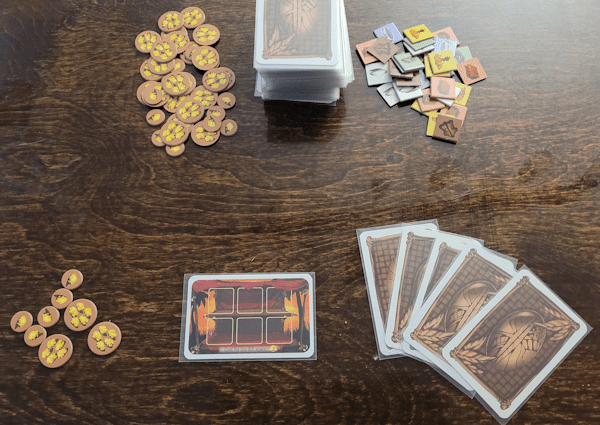
Playing the Game
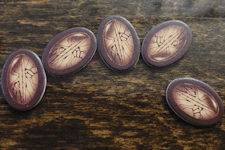
In your turn, you have five “actions” available to you. As you use each action, your opponent will keep track of them via the five “action” markers. Once you use these up (or decide to end your turn), your turn is complete, and play passes to your opponent.
Your turn consists of two phases:
- Phase 1: Draw a Card: you have the option of drawing a card from the card supply. If you do, this costs you one of your actions. If you draw a card and do not like what you get, you may discard that card and draw a new one; this will cost you an additional action. You could cycle through five cards, keeping the last one, and your turn would be concluded, having used up all of your actions.
- Phase 2: Play Cards from Your Hand: there are five kinds of cards in Jambo: wares, animals, people, utilities, and small market stands. Each type of card has a different purpose in the game.
Anytime you play a card from your hand, unless it states otherwise, that card will cost you one action. Assuming you draw no cards in Phase 1, you could play as many as five cards in Phase 2. If you end your turn with two or more actions unused, you get a gold coin as a bonus.
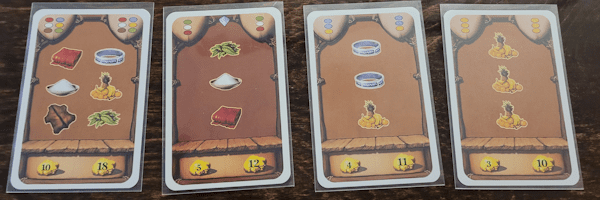
Ware Cards
At the core of the game are the wares. There are six wares you can trade in — fruit, hides, salt, silk, tea, and trinkets. There are six of each of these commodities in the supply; if there are no copies of a commodity in the supply, then a player cannot purchase any more of that type until someone sells some.
Of the 110 cards in the card supply, 40 are ware cards. There are four kinds of ware cards available:
- Three-of-a-kind: some ware cards have three of the same ware pictures on it. This could be 3× silk, or 3× salt, or what have you. These cards will allow you to buy the pictured wares from the supply for 3 gold coins; or, if you have those wares on your market stands, sell them for 10 gold coins.
- Two plus one: some ware cards have two of one kind of ware, and then one of another. This could be 2× fur plus 1× tea, or 2× fruit plus 1× salt, or what have you. These cards will allow you to buy the pictured wares from the supply for 4 gold coins; or, if you have those wares on your market stands, sell them for 11 gold coins.
- Mixed lots: some ware cards have three different wares on them. This could be 1× fruit plus 1× salt plus 1× trinket, or what have you. These cards will allow you to buy the pictured wares from the supply for 5 gold coins; or, if you have those wares on your market stands, sell them for 12 gold coins.
- Six-packs: a few ware cards have one of each of the six wares pictured on them. These cards will allow you to buy one of each ware from the supply for 10 gold coins; or, if you have those wares on your market stands, sell them for 18 gold coins.
These cards are the basis of making money in the game.
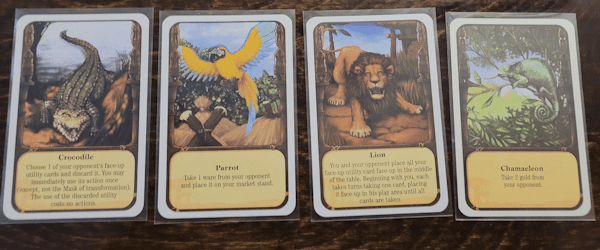
Animal Cards
These are attacks against your opponent. Examples are cards that will destroy one of your opponent’s utility cards (Crocodile), let you pilfer their hand (Hyena), pilfer their market stands (Parrot), and so on. These attacks are not without a defense against them, however. A special people card (Guard) can be revealed and discarded from your hand to stop any animal attack. This defense costs you no actions, since it is played when it is not your turn.
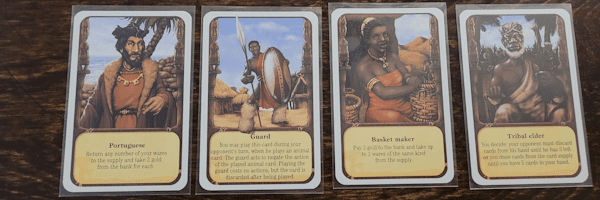
People Cards
These are one-turn bonuses and boons. Examples are cards that let you swindle the supply (Dancer), let you trade wares (Shaman), or purge wares for a small profit that you cannot otherwise sell (Portuguese), and so on.
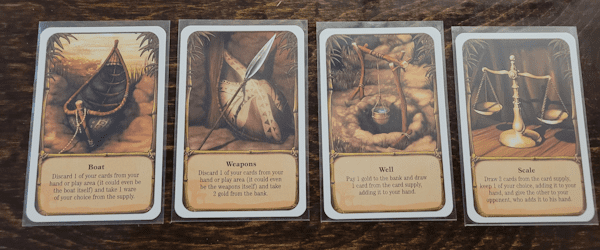
Utility Cards
These act in a similar fashion to animal or people cards. However, rather than being a one-time effect, utility cards remain in play and can be used on future turns to duplicate their effect. Playing a utility card from your hand costs one action; gaining the benefit of a utility card in play also costs one action. You are limited to three utility cards in play. Thus, if you have a fourth you want to play, this will cause you to have to discard one already in play to make room.
Many of the utility cards are “resource exchange” cards. For example, trade one card in your hand or an in-play utility for a ware from the supply (Boat); trade two gold coins for a ware from the supply (Leopard Statue), trade one gold coin for the top card from the card supply (Well), trade one ware on your market stands for a card from the card supply (Drums), and so on.

Small Market Stands
The large market stand you start with can hold six wares. Unless you have room on your stand, you cannot gain wares from the supply. The first five items placed on the market stand are “free” (in that they do not cost you anything more than the purchase price to store there). The sixth one, no matter how it got there, will cost you an additional 2 gold coins (think of it as stress on the stand).
Given the distribution of wares on the ware cards, it is often helpful to have some extra space to store wares. This is where the five small market stands, shuffled into the card supply, come into play. Each one can hold three wares, allowing you to store three more wares as you play, as well as avoid the 2 gold coin penalty for overloading your large market stand by delaying that possibility by three wares. Small market stands are not utility cards, and so do not count toward the limit of three utility cards.
Expanding Your Horizons
There are two expansions for Jambo available from Rio Grande Games. I cannot recommend these enough. Each expansion includes new ware cards, animal cards, people cards, utility cards, as well as new cards that offer you new ways to play the game (huts, carpets, etc.).
Two of the most interesting and useful cards are also two of the simplest ones:
- Two: these ware cards have only two wares pictured. These are always two different wares. These cards will allow you to buy the pictured wares from the supply for 3 gold coins; or, if you have those wares on your market stands, sell them for 7 gold coins.
- Wilds: these ware cards have two crates pictured. These cards will allow you to buy any two wares from the supply for 5 gold coins; or sell any two wares on your market stand for 5 gold coins.
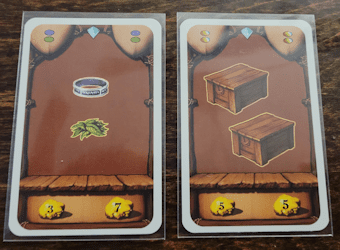
It is amazing what dynamics these two types of card add to the mix of the game. But beyond these two simple additions, you have many, many options with these expansions to make the game of Jambo play any way you like.
In the core game, the Guards are used to stop animals. There is no defense to prevent the boons of a people card. The expansions add in a defense for people (Spirit of the Ancestors) that works the same way: played as a reaction and costs you no actions since it is not your turn.
The rules suggest that you maintain a certain ratio of wares : animals : people : utility. However, in my experience, it is best to set up the entire card supply in such a way as to suit your style of play. If you increase the number of ware cards (in proportion to other cards), the game tends to play faster; if you decrease it it will play more slowly. My ex-wife and I find that a deck consisting of 45% ware cards plays at the rate we like.
Also, as you set up the game to your tastes, picking and choosing which animals, people, and utilities to use (and how many of each to include) can tailor the game even further. Over time, my ex-wife and I have created the style and feel of card supply that we enjoy most. It has remained this way for years. Add in huts, carpets, or other options, and you can see that this game is completely customizable.
A Brief Sidebar
What follows is a look at how I discovered this game and how I fell in love with it.
My ex-wife and I liked to play games together. We were always on the lookout for games that play well with two players. We played Scrabble and Sequence, and other medium-weight games, to smaller and lighter filler games like Fill or Bust, Cinq-O, Catan Dice, and so on. We were always on the lookout for something new, especially if it had some depth to it..
One day, I am in my friendly local game store, and I see Jambo. Next to it is another game with a similar theme. I cannot recall what it was that attracted us to Jambo. Perhaps it was the brightly colored box. Who knows why we decided on this one.
We took it home, opened it up, read the rules together, and played a game. We hated it. I mean, this was terrible. We went turn after turn unable to do anything! We put it down after one play. I was quite sure this would be the last we would see of Jambo.
Flash forward a week or so. My kids were asleep, it was a Friday evening and we both did not care to watch television. So we go back into the game room and look to see if there is a game that trips our fancy. I cannot recall which of us suggested we give Jambo a second chance. That first game? Perhaps it was an odd shuffle. Perhaps we missed something. I have no idea. What I do know is that that second game was lively, fun, interactive, and thought provoking. We fell in love.
In the next 18 months, this was, without a doubt, and by a large margin, the game I played more than any other. I wish this were hyperbole, but my ex-wife and I averaged somewhere between 18 and 22 games each week. If you assume about (52 weeks per year × 1.5 years) 78 weeks, this comes to 1,404 to 1,716 games over that time. Let’s call it 1,500.
To this day, Jambo shows no sign of becoming something we will tire of (yes, we are divorced, but we remain friends and often play games together). I cannot tell you the number of times the kids were asleep, I had finished doing the dishes, and as I exited the kitchen, I would see her mouth the word “Jambo” and we would each go back into the game room, smiles plastered onto our faces, to enjoy our favorite two player card game.
Conclusions
Jambo is a simple to learn, fast-paced, two-player card game that is very entertaining and quite addictive. The game’s strategy changes every time you play it, because the choices you make must take into account the ware cards you are drawing, the utility cards you and your opponent have available, and so on. Honestly, one utility card in play has the power to shift a choice that seems obvious in other circumstances to dicey at best; it can shift a choice you would not normally consider to something that is quite timely and advantageous.
There are some oddities within the game; not flaws, just unexpected twists. For example, there is a card, a People card, in the core set: The Tribal Elder. This is one of the few cards in Jambo that has two possible uses. It can be used to draw your hand up to five cards, or to force your opponent to discard down to three cards. I can recall the first time I used this card in its attack mode. My ex-wife played her Guard triumphantly. I said to her, “This is not an animal.” There was a pregnant pause and an audible blink. She asked how such an attack could be stopped. I thought about it and told her that there is no way to stop it. This has, fortunately, been corrected. See Spirit of the Ancestors above.
I played Jambo some 1,500 times in the time immediately after purchasing it. I am sure I have added some 500+ plays since then. My final assessment is simple. Any game that I can play 2,000 times and still get excited over is an unmitigated success.


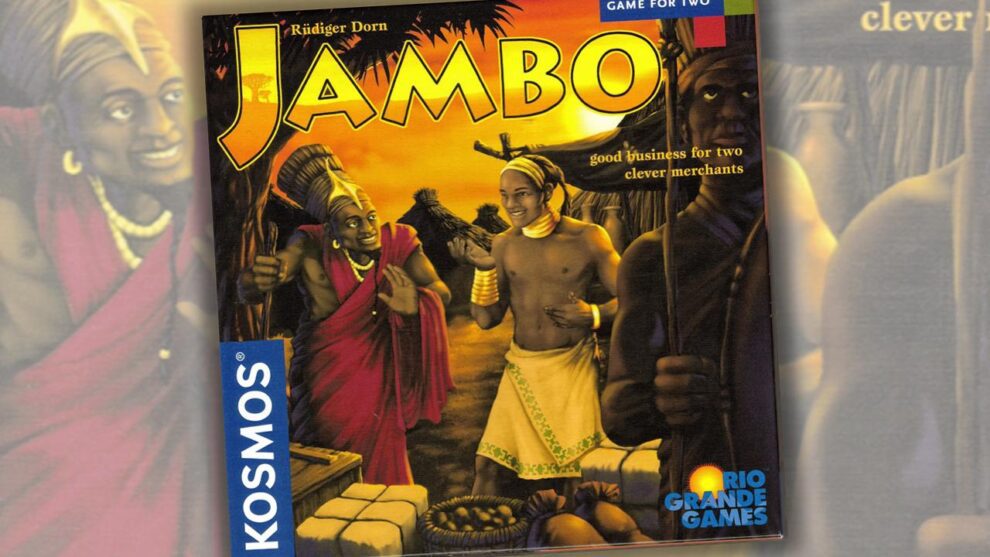

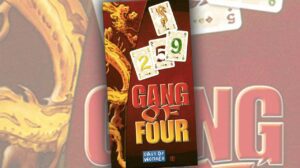






Great job, David, revitalizing this excellent game!